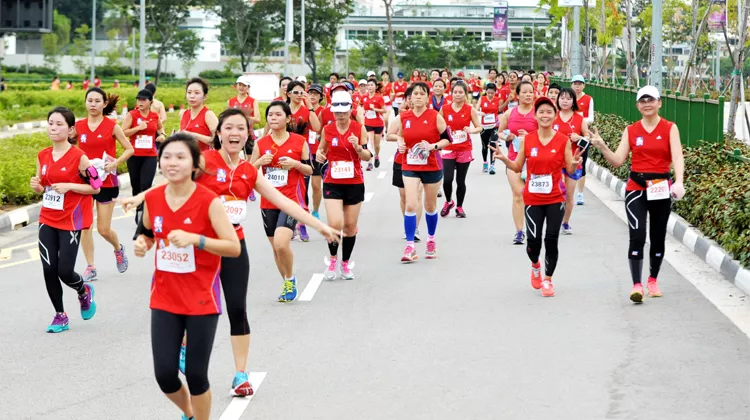


Scientific literature suggests women do get more running injuries than men. This has been attributed to a variety of anatomical and biomechanical factors. Women have a wider pelvis than men and their femur bone is angled inwards more than men, rendering their knee less stable. A difference in strength between the forward-facing thigh muscles
( quadriceps ) and the rear-facing thigh muscles ( hamstrings ) in women further predispose these athletes to knee and lower leg injuries. Hormonal changes associated with different phases of the menstrual cycle is also known to affect the integrity of ligaments, connective tissues and some aspects of neuromuscular control integral to running.
Dr. Gowreeson Thevendran is an orthopaedic surgeon from Mount Elizabeth Novena Hospital Singapore, who specializes in foot, ankle and sports injuries. He shares with us some of the most common injuries suffered by women runners and how to avoid them.
1. Patellofemoral Pain Syndrome (PFPS)
This condition is caused by pain beneath the patella ( knee cap ), as it glides over the femoral notch ( groove in the femur/thigh bone ). This has been attributed in part to weak quadriceps muscles resulting in poor tracking of the patella over the femoral groove. Women runners, in particular, have been shown to have weaker hip abductors and external rotator muscles that contribute to poor patella tracking and PFPS.
How to avoid injury:
PFPS can be prevented with hip and quadriceps strengthening exercises ( lying down sideways and lifting leg away from midline, straight-leg raise exercise and lying clamshell ). Icing after runs and using traditional or flexible athletic tapes on either side of the knee cap is also beneficial.
2. Stress Fractures
Seemingly innocuous activity like running with its repetitive loading can result in stress fractures as the strength of even normal bones is surpassed. Rather than a pure gender inequality, stress fractures are more common in high-intensity female runners and those with biomechanically abnormal feet ( high arched feet predisposes one to fifth metatarsal stress fractures, tight calf muscles may predispose to metatarsal stress fractures )
How to avoid injury:
Constant and localized pain in the lower leg or foot should alert a runner to the possibility of a stress fracture. Consult an orthopaedic foot surgeon if in doubt. Avoidance of running until the fracture has healed and supporting the injured foot with an orthotic ( insole, wedge or heel cup ) and supportive shoes is important. Repeated stress fractures may be the result of a hormonal abnormality ( female athletes triad ) and should warrant further investigations in the way of blood tests and/or an MRI scan.
3. Iliotibial Band Syndrome
The IT band is a strong band of tissue that extends sideways from the hip to the knee and helps to support the knee and leg when the foot first hits the ground when ambulating. It has been associated with running on uneven surfaces, poor footwear and sharp turns. There is scientific evidence linking poor hip abductor and external rotator muscle strength with ITB syndrome in female runners.
How to avoid injury:
Treating ITB syndrome requires changing your ‘running pattern’ and strengthening the hip abductors ( gluteus muscles ) and external rotators ( lying sideways on the ground and raising the leg away from the midline, standing erect and crossing one leg in front of the other, hiking the hip up ) Performing these manoeuvres for 15s each, for 3-4 times per day is essential to improve hip strength and help resolve ITB syndrome. Icing the IT band and massaging the IT band with a roller bar after stretches also helps.
4. Medial Tibial Stress Syndrome or ‘Shin Splints’
Typically resulting in pain across the inside of the shin, this condition is classically associated with runners, with women having a slightly higher prevalence than men. Less experienced runners are more prone as new scientific evidence can now explain this condition to be due to repeated stress across the front of the tibia which gradually resolves as the bone thickens ( remodels ) once the beginner runner acclimatizing to running.
How to avoid injury:
Avoid running once the pain develops as persevering can result in stress syndromes / fractures. Build up a running routine and pace in a graduated fashion, allowing for the bone and muscles to condition itself. Strengthening the calf and shin muscles helps reduce the impact on the bone as one runs and helps reduce the risk of shin splints. There is weak evidence to suggest supportive shoes or running on a soft surface is truly protective.
5. Plantar Fasciitis
This condition irks most runners due to its prevalence and stubborn nature. Typically presents as plantar heel pain, worst with the first step out of bed in the morning and can often persist for months or years before resolving. Plantar fasciitis is commoner in those with flatfeet, overweight and those who have had the condition before. It is caused by degeneration of the foot arch-supporting band of tissue.
How to avoid injury:
Best to avoid running for a short period. Utilize customized heel cups in shoes. Stretching exercises is critical when treating plantar fasciitis, in particular calf stretches and plantar fascia stretches ( flex the big toe up to accentuate the arch of your foot ). Stretching should be done at regular intervals during the day and best to do just before standing up when seated for prolonged periods or before getting out of bed. Supportive shoes with an in-built arch and the use of night splints, even temporarily, is useful. Finally, in refractory cases, shockwave therapy or key-hole surgery is recommended to release the tight plantar fascia.